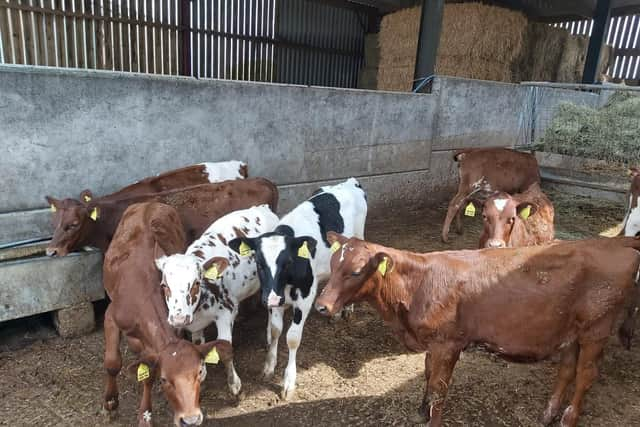Simple calf feeding system at Buxton dairy farm encourages strong rumen development
and live on Freeview channel 276
Andrew and Michael Broadley and their families produce milk from the Whitecroft herd of 160 pedigree Ayrshires and Brundcliffe herd of 50 pedigree Holsteins at 245-acre Brundcliffe Farm, Buxton, producing milk all the year round but with a July – December calving bias.
Milk averaging 4.2% protein and 3.4% butterfat is supplied to Muller on a liquid contract.
Advertisement
Advertisement
The Broadleys calve heifers at 24-26 months, with longevity is strong feature in their herd: 12 Ayrshires and one Holstein have each yielded 100 tonnes of milk, and the oldest, at 16 years, is in calf and approaching a yield of 130 tonnes.


The herd has a 17% replacement rate and the Broadleys sell any pedigree animals that are surplus to their needs.
Sexed semen is mainly used at breeding and Angus and Belgian Blue genetics are also used.
When calving switches to indoors from September onwards, disease pressure can increase but protocols are designed to reduce stress on cows and calves.
Advertisement
Advertisement
When cows are on the point of calving they are moved from cubicle housing to a freshly bedded calving pen.
Newborn calves receive three or four litres of their dam’s colostrum as soon as possible after birth.
Calves are reared in groups of three with each group allocated their own three-bar teat feeder until weaning.
After colostrum, the next five or six feeds are cow transition milk and, for the following 14 days, 750g/day of Bonanza Transformula.
Advertisement
Advertisement
Before the Broadleys were introduced to the Bonanza Calf Nutrition feed range in 2020, outbreaks of calf scours resulting from rotavirus and cryptosporidium infection had been a feature.
But since feeding Transformula there are now only sporadic cases of scours and, when they do occur, the severity and duration of infection is greatly reduced.
“We now have minimal problems transitioning calves from colostrum to milk,’’ said Andrew.
Transformula contains key ingredients found in cow transition milk (transition milk being the 6 milkings post colostrum) supporting the a calf’s naïve small intestine which is underdeveloped at birth.
Advertisement
Advertisement
Selina Field, UK Sales Manager at Bonanza Calf Nutrition, said feeding Transformula helps to bridge the gap between colostrum and calf milk replacer.
“Transformula contains low heat buttermilk - a source of milk fat – and skim milk along with milk oligosaccharides, which are important for promoting gut and microbiome development,’’ she said.
“There is also colostrum fat containing the main source of hormones and bioactive compounds to develop the calf’s digestive system to encourage rumen microbe diversity and ensuring microbe populations multiply.’’
At Brundcliffe Farm, when the youngest calf in the pen is 14 days old, over the course of four feeds the group is gradually switches from 750g of Transformula to 750g Shine Original, a process which takes two days.
Advertisement
Advertisement
The feeding regime changes again when the youngest in the group is 28 days old - calves are then introduced to Shine Original, fed once a day.
For consistency, Andrew and Michael feed Shine Original at the same time daily and at the same mixing rate.
They use a Brix refractometer to crosscheck if the concentration is correct when they are mixing larger quantities of milk.
Selina said research had demonstrated that calves fed Shine Original once a day after 28 days of age weaned on average five days earlier and were 7.8kg heavier at the same age as their counterparts fed twice a day fed (Harper Adams, 2010); this is because calves on this system consume larger quantities of dry feed.
Advertisement
Advertisement
To support this finding further, an INRA feed trial (2011) showed that calves fed once a day had a 30% increase in rumen papillae density than calves fed twice daily, with a 57% greater papillae absorption surface area.
“Andrew’s simple system with good colostrum and transition milk feeding establishes the calf microbiome for strong rumen development further encouraged by feeding milk once a day when the youngest in the group is 28 days of age,’’ said Selina.
Intakes of dry feed at an earlier age ensure calves have no setback at weaning.
Calves are weaned by day 56 when they are consuming 1.5kg of concentrates for three consecutive days.
Advertisement
Advertisement
This is achieved by reducing the volume fed over 7-10 days from when the youngest calf in the group is 42 days of age.
Andrew said the calves have a preference for hay over straw, offered in a rack alongside a 17.5% crude protein starter pellet which is provided ad lib alongside fresh water from day one.
Once calves are nine weeks old they are transitioned onto a rearing nut over seven days which is then offered at up to 3kg/head/day.
Not only are calves healthier on the Bonanza feeding system but there are labour savings too.
Advertisement
Advertisement
Andrew said both milk replacers are easy to mix, and can be done rapidly. “It takes just seconds. This makes feeding time easy and a pleasure.
“This, along with feeding once a day post-day 28, allows us more time to care for slow drinkers which is crucial when calves are fed in groups.’’
The time he saves by feeding once daily means he has more to dedicate to cleaning feeders and managing the groups.